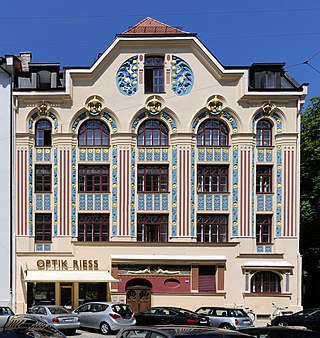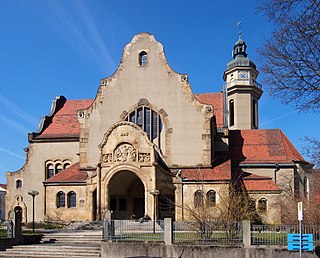
Heimatschutz is a German word which literally translated means 'homeland protection'. The Heimatschutz movement arose in the late 19th century in the wake of the Industrial Revolution, with a focus on nature and landscape conservation as well as the care of historic townscapes, cultural heritage and traditions, folklore and regional identity.

Theodor Fischer was a German architect and teacher.
Heimat is a German word translating to 'home' or 'homeland'. The word has connotations specific to German culture, German society and specifically German Romanticism, German nationalism, German statehood and regionalism so that it has no exact English equivalent. The word describes a state of belonging "the opposite of feeling alien," and its definition is not limited to a geographical place.
The Arbeitsrat für Kunst was a union of architects, painters, sculptors and art writers, who were based in Berlin from 1918 to 1921. It developed as a response to the Workers and Soldiers councils and was dedicated to bringing current developments and tendencies in architecture and art to a broader population.

Gauting is a municipality in the district of Starnberg, in Bavaria, Germany with a population of approximately 20,000. It is situated on the river Würm, 17 kilometres (11 mi) southwest of Munich and is a part of the Munich metropolitan area.

Karl Heinz is an Austrian architect. With two colleagues, as the firm Heinz & Mathoi & Streli, he built private homes in the alpine landscape of Tyrol, schools, offices and public buildings, among others.
Dietmar Eberle is an Austrian architect. Winner of over 150 national and international competitions, he has been a teacher in several universities in North America and Europe. Since 1999 he has been Professor at the ETH Zurich, becoming the Dean of the School of Architecture within the same university between 2003 and 2005. He has also been header of the Center of Housing and Sustainable Urban Development at the ETH Zurich.
Norbert Müller-Everling is a contemporary German artist working with concrete art.

Spa architecture is the name given to buildings that provide facilities for relaxation, recuperation and health treatment in spas. The architecture of these buildings is called "spa architecture" even though it is not a uniform architectural style, but a collective term for a genre of buildings with a spa function.

Michael Trieb was a German architect, urban planner (SRL) and university professor. He was head of the Department of Urban Design at the Urban Planning Institute at the University of Stuttgart and is now Managing Director of the ISA Group - ISA Internationales Stadtbauatelier.

The Freilichtbühne Loreley is an amphitheatre located on top of the Lorelei rock in St. Goarshausen, Germany. Designed by Hermann Senf, it was built between 1934 and 1939 as one of the Nazi Thingplätze and is one of the best known of these. It has been used continuously since World War II, initially mainly for theatrical performances and since 1976, mainly for rock concerts.
Mahmoud Bodo Rasch is a German architect who specializes in the construction of large convertible umbrellas and lightweight structures. He is founder and owner of SL Rasch GmbH Special and Lightweight Structures with branches in Leinfelden-Echterdingen, Jeddah, Mecca and Medina.

Ernst Haiger was a German architect.

Nazi architecture is the architecture promoted by Adolf Hitler and the Nazi regime from 1933 until its fall in 1945, connected with urban planning in Nazi Germany. It is characterized by three forms: a stripped neoclassicism, typified by the designs of Albert Speer; a vernacular style that drew inspiration from traditional rural architecture, especially alpine; and a utilitarian style followed for major infrastructure projects and industrial or military complexes. Nazi ideology took a pluralist attitude to architecture; however, Hitler himself believed that form follows function and wrote against "stupid imitations of the past".
Otto Voelckers was a German architect and technical author.

Kurfürstenplatz is a square in the Munich district of Schwabing and is located about two and a half kilometres north of the city centre. It is the intersection of several streets and tram lines and was built in 1915 and named after the Elector Maximilian II. Emanuel, born in Munich in 1662.

Schule am Meer, also known as S.a.M. or SaM, was a private boarding school on the East Frisian island of Juist in the Free State of Prussia of the Weimar Republic, located between Wadden Sea and North Sea. The school was co-educational and combined elements of holistic and progressive education.
Ernst Huhn (1894–1964) was a German architect who first rebuilt and later designed cinemas, theatres and inns, including the Schauspielhaus Bad Godesberg, Germany's first new theatre after the Second World War

Schmohl & Stähelin was an architecture firm based in Stuttgart, Baden-Württemberg, Germany, extant from 1895 until about 1940. Its principals were Paul Schmohl (1870–1946) and Georg Stähelin, who were responsible for the popularity of the Heimatstil and Heimatschutzstil of architecture in Baden-Württemberg during the first two decades of the twentieth century.

The Rundling, also called "Nibelungensiedlung", is a circular housing estate in the southern part of Leipzig in the Lößnig neighborhood.































